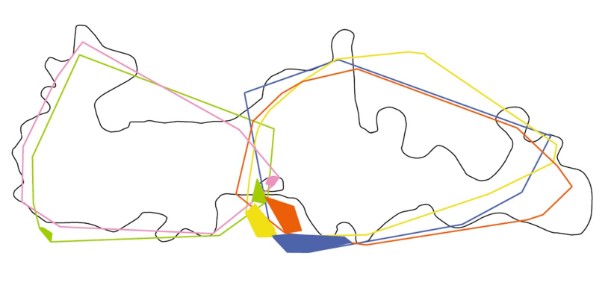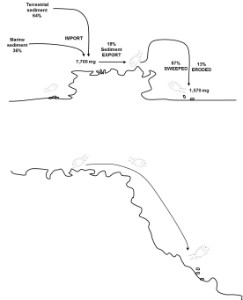Reef sweeper
The bristle tooth surgeonfish Ctenochaetus striatus is common throughout the Indo-pacific coral reefs. The fish uses its broom-like teeth to sweep lose substances into its mouth and defecates outside of the reef crest. It functions as a reef sweeper and helps to keep reef surfaces free of sediments. This is an important function for reef development as too much sediment prevents coral larvae recruitment at the reef crests and therefore the growth of coral reefs.

The home range of five individuals including their defecation sites (filled) at a patch reef.
Investigations into the coral reefs show that it is not only the number and biomass of species that is important to understand reef ecology and reef development, but also the behaviour and function of each species (Bellwood et al., 2004). As outlined earlier (Krone, 2005; Krone et al, 2006), behavioural studies on Ctenochaetus striatus (Acanthuridae) revealed that this fish has taken on a hitherto unknown ecological role as a reef sweeper. Other sediment-moving fish such as the reef scraping parrot fish predominantly transport particles they have eroded from the reef surface (Bellwood, 1995), whilst C. striatus predominantly exports foreign lose sediments. The fish feeds on the sedimentary matter on top of reef patches or on the reef crest and then, at most times, defecates either on sandy bottom (Krone et al., 2011) or on the deep reef slope outside the fish’s browsing site (Krone et al., in preparation).

C. striatus browses on top of reef patches and on reef crests where it ingests marine and terrestrial sediments. It also rasps and ingests calcareous reef rock. All ingested material is defecated around the reef and above sand bottom. When there is a lack of deep sandy places, the fish defecates at the deep reef slope away from its browsing site. In this way the fish transports sediments away from the upper reef zones (Krone, 2012).
Investigations in the Red Sea showed that C. striatus exports at least 18% of the sediment which sinks on a coral reef on a daily basis (Krone et al., 2011). Research into the Great Barrier Reef also supports these finding and revealed that large C. striatus populations may be able to keep reef surfaces free of any sediment (Goatley and Bellwood, 2010). My investigations reveal that the exported sediment also contains up to 13% of matter that C. striatus must have eroded themselves. This must be taken into considerations when interpreting the sediment balance of the Great Barrie Reef and others. At some reefs the C. striatus population can achieve bio-erosion rates which equal those of the sea urchin Diadema setosum (Krone et al., 2011; Schuhmacher et al. 2008a; Kroll, 1995). The example of C. striatus’ reef sweeping underlines once more that inconspicuous species are potentially very important for reef development (Krone, 2012).
Cited
Bellwood DR, Hughes TP, Folke C, Nyström M (2004) Confronting the coral reef crisis. Nature 429: 827-833.
Goatley CHR, Bellwood DR (2010) Biologically mediated sediment fluxes on coral reefs: sediment removal and off-reef transportation by the surgeonfish Ctenochaetus striatus. Marine Ecology Progress Series 415: 237-245.
Kroll DK (1995) Bioerosion by grazing Diadema sea urchins. Facies 32: 170-174.















